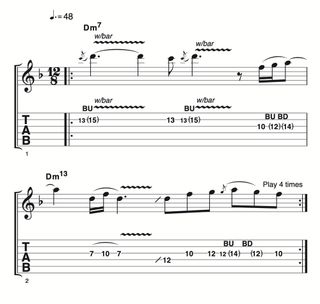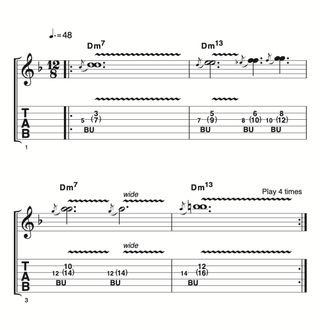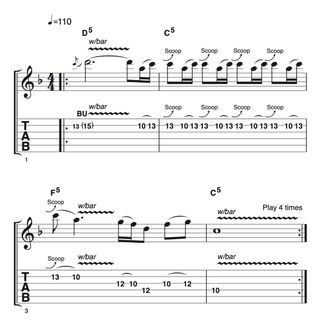10 David Gilmour-style lead ideas you need to try
From funky doublestops to wide interval bends, learn some of the Pink Floyd prog maestro’s masterful soloing techniques

Perhaps more than any other player, David Gilmour is the epitome of the lead guitarist who plays melodically and ‘for the song’.
Though primarily a player with blues sensibilities, Pink Floyd’s progressive nature would see the younger Gilmour become an experimenter both sonically and melodically. Listen to Floyd’s recorded output, particularly from 1973’s Dark Side Of The Moon, nary a note is misplaced, every note counts and every phrase has a purpose.
And, though none of us has Gilmour’s musical ear, we can all learn from the way he approaches playing the guitar and writing songs. From his signature bending technique to his sublime note choice and phrasing there’s plenty in our lesson for you to try out. And once you’ve had a go at our lesson, why not try writing some of your own Gilmour-style licks?
Here, we’re looking at a handful of scales. Get to grips with the shapes and you’ll get a better understanding of his note choice and phrasing. First up is the minor pentatonic scale (shown here in D), which David uses to create those blues-influenced lead lines.
To add some sophisticated colour to the pentatonic sound he’ll often add E and B notes – creating the cooler, sweeter sounding Dorian mode. Our acoustic example is in the key of G major so the G major pentatonic will work here.
Example 1. Spacey Arpeggios

We start with some spacey arpeggios, as heard in classic Floyd songs like Us And Them and Shine On You Crazy Diamond. Using alternate picking may feel a little unnatural at first but it helps to maintain an even feel, especially at the slow tempo of our example.
Example 2. Clean-tone soloing

The key to clean tone solos such as Another Brick In The Wall, Pt. 2 is to select the neck pickup and dial in a fair amount of compression for extra smoothness and sustain. Pick lightly near the end of the fretboard for a fat, expressive tone.
Example 3. Pentatonic scales with added notes

David uses the good old minor pentatonic scale as the backbone of many of his solos, adding the odd extra note for colour. We’re using the D minor pentatonic scale here wiPthamgaejo1r 2ondf (1E) and major 6th (B) intervals added. These notes can also be tasteful points to bend the string from.
Example 4. Funky doublestops

Using doublestops (two notes at once) is a great way to introduce a little funky punctuation to proceedings, and it’s an approach Gilmour uses frequently. Check out Another Brick In The Wall, Pt. 2 at about 2:21 for a typical example of his phrasing. Our lick shows some of David’s typical shapes.
Example 5. Using a fuzz tone

A fuzz pedal can be used to add a crazy amount of sustain. David used this effect to create the soaring solos in songs like Time and Comfortably Numb.
Example 6. Unison bends

With their trademark drawn-out drawling sound, unison bends feature heavily in David’s lead style. Our example should give you the general idea. In each case, bend the third string until it reaches the pitch of un-bent note fretted on the second string. Vibrato is the icing on the cake.
Example 7. Using dotted delays

Run Like Hell from The Wall is one of David’s signature dotted eighth note delay moments. For our simpler example we’ve set a tempo of 120 bpm with, therefore, a delay time of 375ms. For the full Run Like Hell effect, keep the number of repeats (aka feedback) fairly high for a cascading, layered sound.
Example 8. Wide-interval string bends

We’ve already shown you how David executes those huge wide-interval bends in tracks such as Another Brick In The Wall, Pt. 2 and Shine On You Crazy Diamond, but now it’s your turn to try it out over our backing track. We’ve stuck to three-semitone bends here, but you could try a four-semitone bend in bar 2 if you’re feeling brave.
Example 9. Whammy bar use

One of David’s signature sounds is the addition of vocal-like whammy bar vibrato on string bends and long held notes. He also uses the bar for ‘scoops’, such as in the repeating phrase idea we’ve included here in our tab example.
Example 10. Acoustic lead

David is no stranger to the acoustic guitar and used it to great effect for songs like Wish You Were Here and Lost For Words. As with many of Gilmour’s melodic ideas, simplicity is the key here.
Get The Pick Newsletter
All the latest guitar news, interviews, lessons, reviews, deals and more, direct to your inbox!
Jon Bishop is a UK-based guitarist and freelance musician, and a longtime contributor to Guitar Techniques and Total Guitar. He's a graduate of the Academy of Contemporary Music in Guildford and is touring and recording guitarist for British rock 'n' roll royalty Shakin’ Stevens.




![Joe Bonamassa [left] wears a deep blue suit and polka-dotted shirt and plays his green refin Strat; the late Irish blues legend Rory Gallagher [right] screams and inflicts some punishment on his heavily worn number one Stratocaster.](https://cdn.mos.cms.futurecdn.net/cw28h7UBcTVfTLs7p7eiLe-840-80.jpg)






